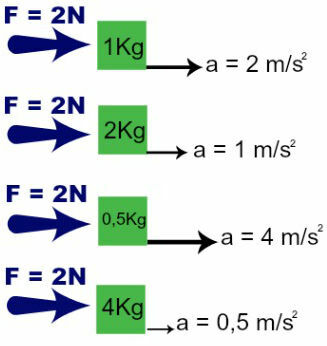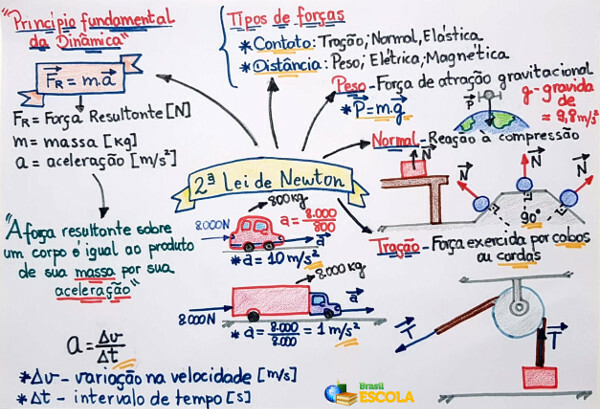According to the Newton's Second Law:
“The resulting force acting on a body is proportional to the product of the mass and the acceleration acquired by it.”
This relationship can be described with the equation:
Fr = m. The
being:
Fr – Resultant Force;
m – mass;
a – acceleration.
According to this Law, in order to change the state of motion of an object, it is necessary to exert a force on it that will depend on its mass. THE acceleration, which is defined as the variation of speed over time, will have the same direction as the applied force, as shown in the figure below:

When applying a force on an object, we imprint an acceleration on it that will be dependent on its mass.
We can see from the figure that, when applying a force of 2N on an object, it will acquire a higher acceleration when the mass is 0.5 kg and a lower acceleration when the mass is 4 kg. This means that the greater the mass of a body, the greater the force applied to change its state of motion.
Being the inertia defined as the resistance of a body to change its state of motion, we can say that the
Newton's second law also defines mass as a measure of the inertia of a body.strength is a Vector greatness, as it is characterized by module, direction and direction. The unit in International System for force it is Newton (N), which represents kg m/s2.
Do not stop now... There's more after the advertising ;)
Mind Map - Newton's 2nd Law

To download the mind map in PDF, Click here!
THE Newton's Second Law is also called Fundamental Principle of Dynamics, since it is based on it that force is defined as a quantity necessary to overcome the inertia of a body.
strength weight
From the Newton's Second Law, we also come to another important definition in Physics: Weight.
THE strength weight corresponds to the attraction exerted by a planet on a body on its surface. It is calculated with the equation:
P = m. g
*g is the gravity acceleration local.
Although the mass of a body is fixed, weight is not. See an example:
A body of mass 20 kg on planet Earth, where the acceleration due to gravity is 9.8 m/s2, has the following weight:
P = 20. 9,8
P = 196 N
The same body on Mars, where g = 3.711 m/s2, has the weight:
P = 20.3.711
P = 74.22 N
We see that the weight on the planet Mars is much less than on Earth, as gravity on Mars is lower. This is because the gravity of a particular location depends on the mass of the body. Since Mars is less massive than Earth's, it will also have a lower gravity.
By Mariane Mendes
Graduated in Physics
Mind Map by Rafael Helerbrock
Would you like to reference this text in a school or academic work? Look:
TEIXEIRA, Mariane Mendes. "Newton's Second Law"; Brazil School. Available in: https://brasilescola.uol.com.br/fisica/segunda-lei-newton.htm. Accessed on June 27, 2021.

